This is my report on a visit to tour the former Canadian
Pacific Great Lakes Steamship, “S.S. Keewatin”, now on permanent display at Port
McNicholl, Ontario. This vessel is part of my personal history as well as part
of the history of passenger steamships on the Great Lakes. The former is
covered in my article for “Branchline” railway magazine, see
http://www.railways.incanada.net/Circle_Articles/Article_Page04.html,
also on file at the Marine Museum. The latter is obviously a much broader
subject, although well entwined with my lifelong interest in railways and
ships.
Background
Before this visit, I was last on board the “Keewatin” in
1959, during one of several family trips from the Lakehead to Port McNicholl on
Georgian Bay. When the “Keewatin” was taken out of service in 1965, I was
saddened at the thought of this fine ship probably facing the scrapyard. After
it and its sistership, the “Assiniboia”, which stayed in freight-only service
until 1967, were gone, the end of Canadian overnight steamer service also
occurred. “Sic transit....”, as they say. It was not long, however, that both
ships appeared to have been reprieved, by having been bought by interested
parties for display and other uses. The “Assiniboia” sailed back down the St. Lawrence River, the first
time since 1907, this time not needing to be cut in half to pass through the Seaway
locks as was the case on the way in from Britain. Her life at a new home in the
US was, however, cut short by a fire shortly thereafter, thus ending her
history.
The “Keewatin” fared much better, having been purchased
by a Mr R. E. Peterson, a US businessman. Mr Peterson set up the retired ship
as a personal museum artefact, at Saugatuck Michigan. Thanks to his loving
care, the “Keewatin” was thus preserved in both mind and body for 45 years
until Mr Peterson could no longer do his best for her.
The current situation
Through the incredible efforts of “Keewatin” enthusiast,
one-time crewmember, and Toronto businessman Eric Conroy, the ship was procured
and moved from Michigan to its former home port of Port McNicholl. The steps
needed to make this move are a story in their own right, many seemingly
impossible. This is not a word in Eric’s vocabulary, however, and his
determination saw the final move take place in the summer of 2012. The ship is
moored alongside its old dock, although about 500m/1500ft further up the bay
than its former commercial docking position. It is the centrepiece of a
development project including luxury waterfront homes, a yacht club and a
property landscaped as in former CPR days. The development seems to be moving
very slowly, and so the “Keewatin” appears somewhat isolated, as shown in photo
no. 1. Let’s hope that this situation improves.
The visit and tour
After a number of email exchanges over the past year, I
finally met Eric in person at a presentation he was making last May before a
service group in Barrie. He said that he enjoyed the 1950s colour slides I had
sent him, showing our family travelling in style on the “Keewatin”, see photo
no. 2.
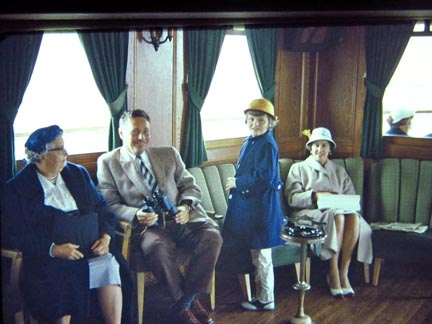
Photo No. 2 50s Family on the Keewatin
After a short chat, Eric told me to contact him before
any planned visit to tour the ship. I did this and, with my friend Jim from
Barrie, we arrived at dockside on 11 September (2013). Shoreside there are only
visitor toilets (clean...maintained
by “Keewatin” volunteers), everything else is on board the ship, accessible
through the gangway doors at dock level. We headed for the “Enter here” gangway
and immediately were at the ticket desk and gift shop. This open space, once
used for c35 automobiles in transit, now has a number of exhibits: photos,
models and artefacts. It is also the site of the Purser’s Office, the “front
desk” back in passenger days. See photo no. 3.
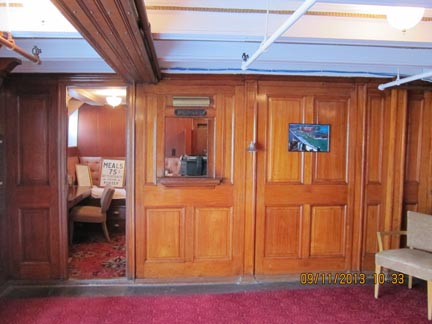
Photo No. 3 Pursers Office
We picked up our senior tour guide, Al Mantel, who, like
all volunteer guides, was sporting a smart-looking CP Steamships shirt,
complete with the CPR red and white checkerboard flag.
Al started with the “technical tour” option (we had
requested both this and the upper decks tours), and headed for a companionway
ladder into the aft cargo hold. I must admit that, while I knew the “Keewatin”
carried freight, I never realised how much...over 2000t.... and where it was
stored. The aft hold is quite large,
when you think that the ship is only 45ft beam. This, and each of the other
holds (aha, now I know why there were so many gangway doors!) was served by a rope
hoist, driven off a fore-and-aft lineshaft on the car deck. Pallets of cargo,
eg: bagged grain, were raised and lowered by these hoists, with the help of
many men. Slow work, but profitable enough for CPR to keep it going.
From the hold, we moved aft past coal bunkers nos. 1 and
2, each holding about 125t of coal. Between the bunkers were the four Scotch
marine boilers, back to back and two across. The two forrard boilers have been
wisely removed, and one of remaining ones sectioned and well-lighted to
demonstrate water and fire passages, see photo no. 4.

Photo No. 4. Boiler Section
In the middle of
the aft coal bunker was a low passageway through to the engineroom...I
recognised it right away!
Now, the engineroom....what can I say: the heart of the
ship! The engineroom is open to escorted visitors. It is packed with machinery,
the centrepiece of which is the 3500hp quadruple-expansion engine which drives
the single propeller shaft. This engine represents the high water mark of
marine steam engine design. The physical size of the engine is mind-boggling.
All the controls are at the base level and easy to see and figure out, see
photo no. 5. The motion of all the reciprocating components can be seen in very
slow motion because an original engine turning device has been motorised for
display purposes. Connecting rods the size of tree trunks convert reciprocating
motion to rotary motion just as they did in real service, see photo no. 6.
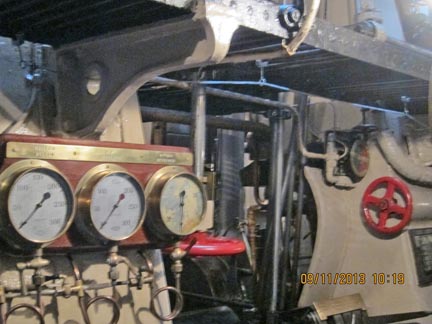
Photo No. 5 Engine Control Station | 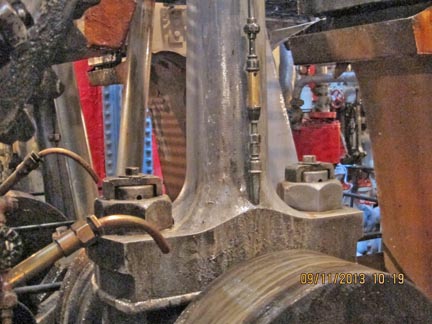
Photo No. 6 Con rod close up |
The rest of the engineroom contains all the auxiliary
pumps, generators, and other devices necessary to operate a ship of this size.
After plenty of discussion down below, we followed Al
back up to the main deck and started the passenger-level tour. The “Keewatin”
had berths in cabins for 288 passengers and crew space for 84 members. The
former were located on the main and upper decks, in cabins that ranged from
inside with upper and lower berths (no window, washrooms down the passageway)),
to twin beds with ensuite bathroom and porthole or window. For display many
cabins are open to view, with clothing of the era laid out ready to wear, along
with magazines and newspapers of the day. See photo no. 7. This material has
been donated by individuals, and carefully vetted for authenticity. At each
cabin door there is also a small note indicating the cost of this accommodation
at certain years. Most were in the range of $45 - $ 65, some for round trip,
others for singles. Probably not cheap in the day, bearing in mind that the 2 ½
- day voyage was an alternative to the 24 – hour train trip covering the same
distance.
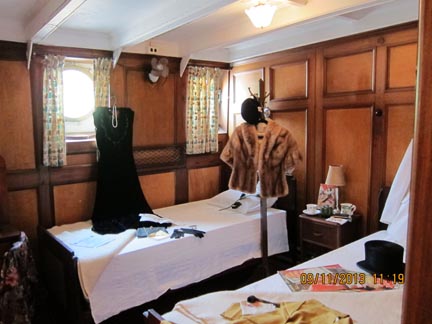
Photo No. 7 Keewatin Suite | 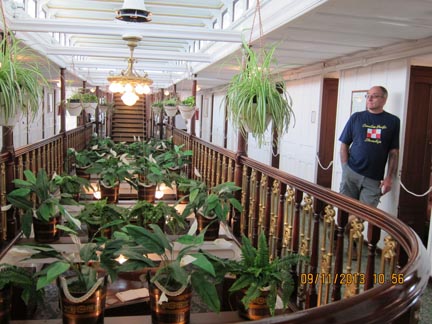
Photo No. 8 Keewatin Flower Lounge |
The public spaces on the “Keewatin” were and still are
very classy. One of the best remembered is the “Flower Lounge”, with its
display of potted live flowers forming a “ceiling” between the main and upper
decks. See photo no. 8. The other lounges at the fore and aft ends of the upper
deck are just as I remembered, right down to the seating. Some additional
furniture and fittings have been donated to fill in the few places where the
originals were missing. These too have been carefully chosen to ensure accuracy
and age.
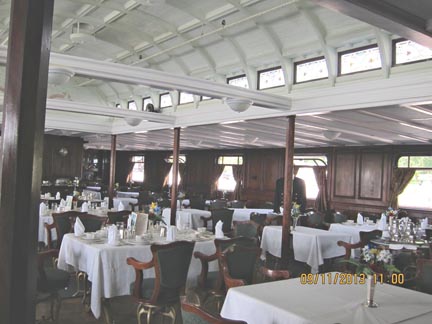
Photo No. 9 Keewatin Dining Saloon.
The dining saloon on the upper deck is perhaps the most
elegant of all the public spaces, see photo no. 9. Everything in it is
original: china, cutlery, tables. It is set up for dinner and is just
marvelous. The ceiling skylight clerestory has a series of stained-glass panels
which are bright and beautiful in daylight. A Scottish stylish crest adorns one
gable end of the clerestory.
The adjacent bar is woody, dark and polished, with
hand-carved bas-reliefs of the peoples of the British Empire of the day on the
walls.
Now a few words about the crew during operating days.
Their responsibilities were wide-ranging and varied. Hints of crew life are
visible in their quarters, some of which are open to view. One door is marked
“Stewardesses” on a metal plate on the lintel. Inside are three bunks, closets,
and a sink and dressing table. The “Stewardesses” were on board “to attend to
lady passengers’ needs”.
The gallery and bakery employed 17 men, all of Chinese
origin, per Canadian Pacific tradition. The galley produced c 1000 meals a day
in high season. The huge chopping block in the galley is the first and only
one, as fitted in Glasgow.
Other staff included the ship’s officers, with their own
public dining table in the dining saloon, radio operators (the “Keewatin” was one
of the first vessels on the great lakes to be fitted with radar, right after
World War II), deckhands, waiters (nearly all university students),and even a
barber, see barber shop, photo no. 10, and many more in the engineroom and room
steward service, totaling over eighty persons.
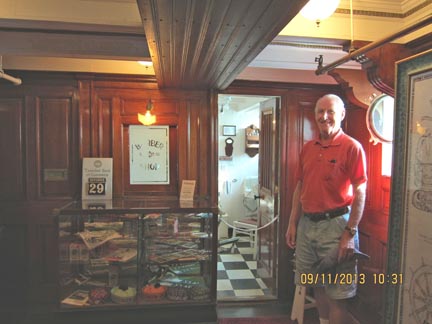
Photo No. 10 Keewatin Barbershop
Certain areas on board are not open to visitors at
present, including the open top deck, the wheelhouse, and the radio room. These
spaces are slated for repair and refurbishment and eventually should be open. A
local ham radio club may be occupying the radio room, giving it a realistic
touch.
Before departing the ship, I took one more photo, see no.
11, looking forward from the bow, with a fine view down the harbour toward the
housing development at the mouth of the old CPR port. Much work still has to
done to fill in the intervening space and ensure that the “Keewatin” remains
the focal point of a great project.
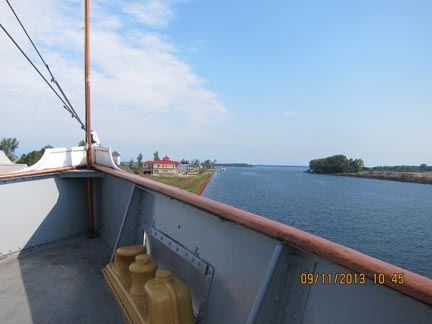
Photo No. 11 Keewatin view from bow.
D. H. Page,
Kingston, 24 September 2013.
Footnote:
Port McNicholl is just off Highway 12, about 10km west of Highway 400,
and 10 km east of Midland. It isabout 400km and 4-5 hours drive from
Kingston.
